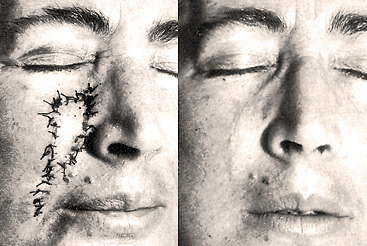
Rosa Mosqueta Oil Clinical Trials
Success rate: over 90% in clinical trials
 Clinical research, both in Europe and South America, has proven repeatedly that Rosa Mosqueta oil really is the product to reduce scars, combat wrinkles, stretch marks and other signs of skin-ageing. In one trial, Spanish dermatologists used Rosa Mosqueta oil in a clinical setting for the treatment of all kinds of scars - including severe post-operative scarring. In more than 90% of the treated cases, the results were deemed to be “very satisfactory” after only six months of continued use.
Clinical research, both in Europe and South America, has proven repeatedly that Rosa Mosqueta oil really is the product to reduce scars, combat wrinkles, stretch marks and other signs of skin-ageing. In one trial, Spanish dermatologists used Rosa Mosqueta oil in a clinical setting for the treatment of all kinds of scars - including severe post-operative scarring. In more than 90% of the treated cases, the results were deemed to be “very satisfactory” after only six months of continued use.
Tell me more…
The remarkable properties of Rosa Mosqueta oil were first identified in 1983 by researchers at the Faculty of Chemistry and Pharmacology at the University of Concepcion in Chile. Scientists there conducted a two-year study into the regenerative properties of Rosa Mosqueta oil on skin damaged by surgical, traumatic, and post burning scars – as well as a number of patients suffering from premature ageing of the skin. They found the oil not only helped to attenuate scarring, but also reduced wrinkles and improved skin colour and tone.
Since these initial South American studies, Rosa Mosqueta oil has been the subject of several other clinical trials. The two most recent trials, conducted at the dermatological department of the University of Seville in Spain, produced results that researchers deemed to be ‘very satisfactory’ in more than 90% of cases. The clinical trials were conducted on patients with post-operative and post-acne scarring and these excellent results were achieved after just six months of continued use.
Active ingredients :
The positive action of Rosa Mosqueta oil in helping to regenerate skin tissues is in part attributable to its extremely high content of unsaturated Essential Fatty Acids, or EFAs - namely Gamma Linoleic Acid (44-50%), Alpha Linolenic Acid (30-35%), and Oleic Acid (15-20%). They are called “essential” because our body is not able to produce them for itself, but instead must rely on uptake from dietary sources. EFAs are crucial nutrients for the maintenance of healthy skin as they are used to produce prostaglandins that provide tissue regenerating and rejuvenating effects and can also act to reduce inflammation (hence Rosa Mosqueta oil's benefit to skin troubled by many minor skin conditions).
However – this high content of EFAs did not wholly explain Rosa Mosqueta’s powerful healing effects – especially when it came to the oils ability to reduce the appearance of surgical and accidental dermal scars and to eliminate certain hyper-pigmented spots and lessen wrinkles.
Trans-Retinoic acid :
In 1988 – Dr Bertha Pareja and Dr Horst Kehl successfully identified the presence of trans-retinoic acid as the other component responsible for the remarkable healing properties of Rosa Mosqueta oil.
Trans-retinoic acid, a natural source of Vitamin A, is nature’s equivalent to pharmaceutical skin treatments such as Tretinoin that have been well-researched and recognised for almost 30 years. The most significant results have been produced in the treatment of photo-aged skin and skin damaged by excessive exposure to sunlight. Tretinoin can produce quick and positive changes in the skin, but because it is a very strong substance, it must be applied under medical supervision.
Rosa Mosqueta oil produces the benefits of Tretinoin, but without secondary side effects, because the trans-retinoic acid contained in it is in a natural state as part of a complex system of unsaturated fatty acids. This means that its action is controlled and slowly released, eliminating the risk of overdose.

